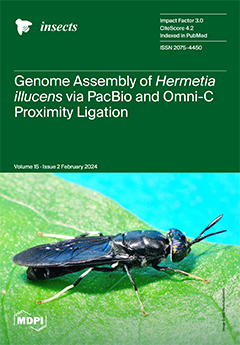Wolbachia bacteria (phylum Proteobacteria) are ubiquitous intracellular parasites of diverse invertebrates. In insects, coevolution has forged mutualistic associations with
Wolbachia species, influencing reproduction, immunity, development, pathogen resistance, and overall fitness. However, the impact of
Wolbachia on other microbial associates within the insect microbiome,
[...] Read more.
Wolbachia bacteria (phylum Proteobacteria) are ubiquitous intracellular parasites of diverse invertebrates. In insects, coevolution has forged mutualistic associations with
Wolbachia species, influencing reproduction, immunity, development, pathogen resistance, and overall fitness. However, the impact of
Wolbachia on other microbial associates within the insect microbiome, which are crucial for host fitness, remains less explored. The diamondback moth (
Plutella xylostella), a major pest of cruciferous vegetables worldwide, harbors the dominant
Wolbachia strain
plutWB1, known to distort its sex ratio. This study investigated the bacterial community diversity and dynamics across different developmental life stages and
Wolbachia infection states in
P. xylostella using high-throughput 16S rDNA amplicon sequencing. Proteobacteria and Firmicutes dominated the
P. xylostella microbiome regardless of life stage or
Wolbachia infection. However, the relative abundance of dominant genera, including an unclassified genus of Enterobacteriaceae,
Wolbachia,
Carnobacterium, and
Delftia tsuruhatensis, displayed significant stage-specific variations. While significant differences in bacterial diversity and composition were observed across life stages,
Wolbachia infection had no substantial impact on overall diversity. Nonetheless, relative abundances of specific genera differed between infection states. Notably,
Wolbachia exhibited a stable, high relative abundance across all stages and negatively correlated with an unclassified genus of Enterobacteriaceae,
Delftia tsuruhatensis, and
Carnobacterium. Our findings provide a foundational understanding of the complex interplay between the host,
Wolbachia, and the associated microbiome in
P. xylostella, paving the way for a deeper understanding of their complex interactions and potential implications for pest control strategies.
Full article






